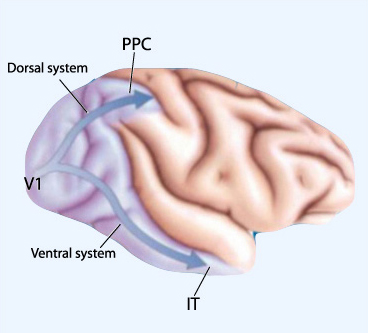Visual agnosia
From Psy3242
Contents |
Defined
Visual agnosia comes about from a lesion in the posterior occipital lobe and/or the temporal lobe of the brain, often caused by a stroke. Patients with visual agnosia have the inability to make sense of certain aspects of incoming visual stimuli. More specifically, visual agnosics often do not grasp the “bigger picture” of what they are looking at. For instance, many visual agnosics can describe the color, texture, or even the shape of an object, yet cannot say exactly what the object is. So while all of the correct visual stimuli is being received, the legion suffered by visual agnosics disallow them to recognize familiar objects and faces. Research on visual agnosia shows us that different parts of the brain compute different aspects of the same information retrieved from the retina.
History
In Goodale et al (1992), researchers postulated that two streams of vision give rise to this unique disorder. Basically, they believed that a dorsal stream was responsible for more primal aspects of vision (i.e. aiming movement), and a ventral stream was more responsible for the higher cognitive perceptions of the world. They dubbed these pathways the action stream and the perceptual stream, respectively.
Visual agnosics were then classically subcategorized as either one of two types:
(1) Apperceptive agnosia: Individuals diagnosed with this form were able to identify parts of an object, just as the presence of a handle on a coffee cup, but were unable to identify the cup itself. In Benson & Greenberg (1969), Mr. S described a safety-pin as silver and shiny but could not recognize the object, nor could he recognize letters, numbers, or faces.
(2) Associative agnosia: Individuals diagnosed with this form were able to copy objects, pick out objects similar to other objects, and even categorize them, but could still not identify what the object was. Researchers suggested that the problem was in linking perceptual information to semantic content.
The basic observed difference between the two was in the ability to copy drawings. The neurological basis of this comes from the extent of the damage to the ventral processing stream. Basically, apperceptive agnosics display damage to an earlier stage of the ventral processing stream, which is why associative agnosics have a better, although still impaired, ability to recognize objects.
Patients
DF- MRI scans showed damage to the lateral occipital cortex (a ventral stream structure). As expected, he could not describe objects’ size, shape, or orientation, yet demonstrated appropriate grasping motions when reaching for those same objects. Apparently, DF had a sort of underlying visual conception objects, but which did not reach conscious interpretation.
JL- could recognize objects in standard orientations but had trouble recognizing them when presented end-on.
AB- could draw/match/identify unusual objects, but was profoundly impaired at object/picture naming and describing functionality. This case implied semantic memory deficits.
HJA- could define a carrot when asked verbally, but could not identify a picture of one. Could name objects by touch that he could not identify verbally. This case implied intact memory but problems visually activating it.
Modern View
The previous three patients exemplify a more complicated picture of visual agnosia than that entailed in the classical definitions. More research on visual agnosia suggests that these classifications are too basic, as many patients have sensory deficits working in tandem with these perceptual deficits (i.e. blind spots called scotomas).
Although many modern theories have surfaced to help explain the disorder, Ellis and Young’s ideas merit special attention as they attempted to integrate all other models. They proposed a set of sequential stages in visual perception that lead to correct object recognition: 2D- ‘primal sketch’ includes information about boundaries, contours and brightness fluctuations, but not overall form. 2.5D- viewer-centered information about form and contour but not object constancy or perceptual classification. 3D- true object (rather than viewer) centered mental representation, independent of viewer’s position, specifying the real 3D shape of an object from any view, enabling true object recognition.

